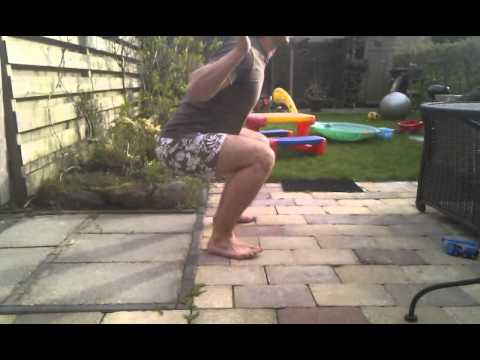As I see it, there’s two ways to squat in PL and the grey area inbetween. There’s what I call the American power squat and the Russian powersquat.
American Powersquat:
This is what you see advocated by Louie Simmons and Dave Tate and in the ‘So you think you can squat’ video series. This is where you put the bar as far back (not down) on your back as you can. You then sit way back and force your knees out hard with little to no forward knee travel. Also, a wide stance is used to decrease the ROM and utilize the hips and P-chain more. In a nutshell it’s a squat based on hip extension and hip abduction with little knee extension.
Pros
-there’s very little knee stress
-the bar travels the least distance to reach parallel
-you’re heavily emphasizing the most powerful muscles of your body, your hips, glutes, and hamstrings
Cons
-a lot of stress on the hips, and due to the back angle lots of stress on the low back
-for a lot of people squatting raw, there isn’t as much spring and rebound in the hole
-the low bar position can be hard on the wrists, elbows, and shoulders
-this type of squat doesn’t have quite as much carry over to other types of athletics like sprinting and jumping
Russian Powersquat
This is basically an Olympic weightlifting squat done to parallel instead of atg. There’s a lot of knee travel (but the weight stays on the heels/mid-foot). You sit much more down than back. The bar is held high on the traps to emphasize keeping the back upright and sitting down instead of back. The stance is shoulder width or narrower. In my experience you still push your knees out but not as hard as with the former squat. Your back will tend to be much more upright. Most that squat this way use weightlifting shoes or some shoe with a little to a lot of heel lift. I prefer a .75in heel lift myself and this is my preferred squat style.
Pros
-not as much back or hip stress due to the more upright position
-more rebound and ‘pop’ out of the hole
-easy on the shoulders, wrists, and elbows
-more carryover to other athletic activities
Cons
-the bar travels further
-extra stress on the knees
There’s nothing right or wrong about one style or the other it’s just a matter of what kind of gear you’re using and your preference. In IPF singleply and raw lifting you see more the Russian style squat because IPF and USAPL require greater depth and it can be easier with the Russian style squat and you don’t get the support in the bottom of the squat from heavy gear. In the heavier gear divisions the gear provides so much pop in the bottom of the squat that you see more of the American style squat.
And it doesn’t even have to either/or. You can blend the two together. You can have wide stance, high bar, back fairly upright squat for example. Or you could have low bar squat where you stay fairly upright, your stance is narrow, and your knees travel a bit.
If you get only one thing out of this post, it’s that there’s only a handful of essential rules about the squat and the rest is preference and up to you to figure out. Look at top lifters with a similar build and weightclass as you and see how they squat. Look at their openers or training videos because by the time they get to their final attempt the form can get ugly. Start by imitating what they do and then over time modify it according to what suits you.

